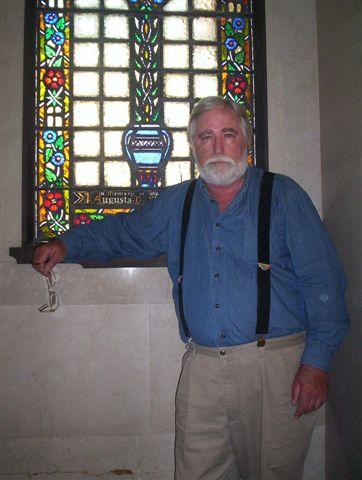
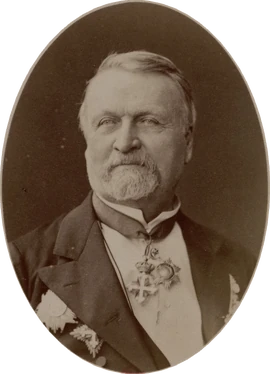
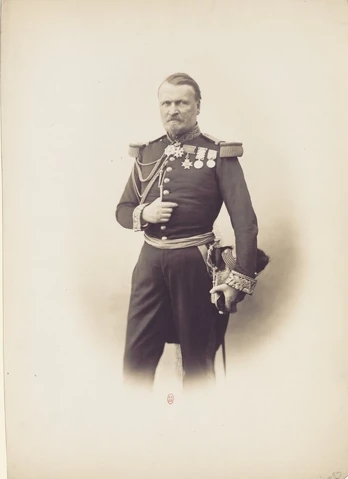
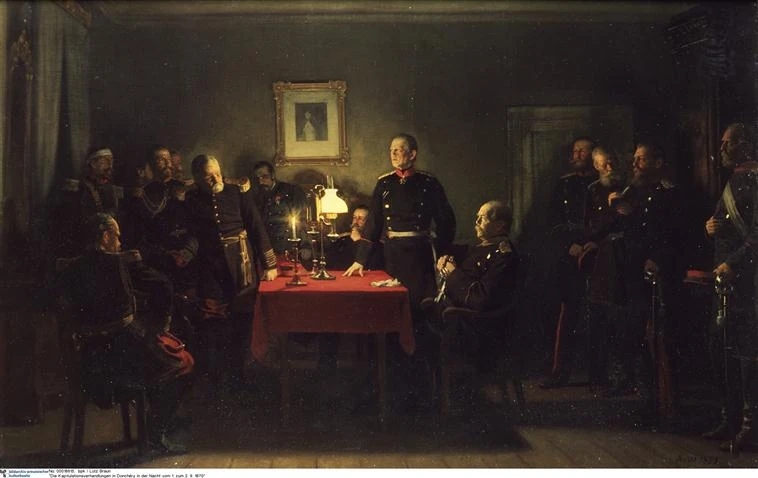

My great uncle, Frederick Broderick, said Stuttmeister was not the last name. On June 20, 2024 I believe I found my military family and roots. Above is a painting of Emanuel Felix de Wimpffen surrendering after he lost the Battle of the Sedan, where Napoleon 3 was taken prisoner. This loss changed the world. Napoleon was trying to create The Second Mexican Empire, not only in Mexico, but California. My kin, John Fremont was aware of these ambitions that hinged upon the Confederacy winning the Civil War. I suspect Fremont had a contingency plan to join the Empire of Napoleon, and as his top General, keep Confederate America – at bay!
Juneteenth has just ended.
Baron John Presco
A member of the Wimpffen family, de Wimpffen was born in Laon, the illegitimate son of Baron Félix Victor Charles Emmanuel de Wimpffen by Cornélie Bréda. His father was a general in the French Army who had been created a Baron of the Empire in 1810. In 1836 he was recognized by his father.
Félix Victor Charles Emmanuel de Wimpffen
https://aigles-et-lys.fandom.com/fr/wiki/F%C3%A9lix_Victor_Charles_Emmanuel_de_Wimpffen
On 5 October 1825, he married Baroness Maria Anna Marianne Cecilia Bernhardine von Eskeles (1802-1862), who converted from Judaism to Catholicism, in Hietzing, Austria. She was born at the Palais Eskeles, Vienna, Austria, on 2 March 1802, daughter of Bernhard von Eskeles and wife Caecilie (Zipperche) Itzig, from whom she inherited a fortune in stocks and bonds, and died in Munich, Bavaria, on 10 August 1862.
Bernhard, Knight and Baron von Eskeles (German: Bernhard Ritter und Freiherr von Eskeles) (12 February 1753, Vienna – 7 August 1839, Hietzing (near Vienna, now Vienna)) was an Austrian–Jewish banker/financier and court Jew.

Early life
He was born Bernhard Eskeles, the posthumous son of Rabbi Issachar Berush Eskeles,[1] son of the Polish–Moravian Rabbi Gabriel Eskeles. At an early age he went to Amsterdam, where he entered a commercial house, of which he became manager at the age of 17, but met with reverses, and lost the fortune which his father had left to him.
Biography
In 1774 he returned to Vienna and entered the business of his brother-in-law Nathan Arnstein, with whom he established the banking-house of Arnstein and Eskeles, which came into great prominence during the Congress of Vienna. They were patrons of Mozart and also of Ignaz Moscheles who gave piano lessons to Caecilie. At this period Eskeles’s drawing-room was the rendezvous of men like Talleyrand, Wellington, Castlereagh, Hardenberg, and Theodor Körner. Eskeles’s name is often mentioned in the memoirs of this time. His advice in financial matters was frequently sought by Emperors Joseph II, and later by Francis II and I, who entrusted him with many important missions to foreign countries. He was sent to Paris and Holland in 1810. Eskeles was the founder of the Austrian National Bank (1816), and its director for 23 years. He was raised to the Austrian nobility in 1797, and became a knight in 1811, and a baron in 1822.
Eskeles took little interest in Jewish affairs, and during his short term of office as representative of the Jewish community new and vexatious measures were introduced which, according to his contemporaries, he might have prevented had he used his influence. He was, however, the founder of several charitable institutions. He also established, with an initial contribution of 50,000 florins, a fund for the maintenance of poor students.
Personal life
He was married to Caecilie (Zipperche) Itzig (1760–1836), daughter of Daniel Itzig of Berlin. They had two children, a son, Denis, Baron de Eskeles (1803-1876), and a daughter, Maria Anna (Marianne) Cecilia Bernhardine Freiin von Eskeles, Countess of Wimpffen, wife of Franz Graf von Wimpffen, deserted Judaism. Denis, who succeeded his father in the management of the banking-house, married Wilhelmina, Baroness Brentano-Cimaroli, and by his death the male line of the house became extinct.
The Wimpffen family is an old and distinguished Austrian noble family, originally from Württemberg in what is now Germany.

History
Originating in Württemberg, the family became prominent in the Kingdom of Bohemia during Habsburg rule, while its members held significant military positions throughout the Empire. On 8 April 1797, they were awarded the title of Count by Leopold II.[1]
Notable members
- Emmanuel Félix de Wimpffen (German: Emmanuel Felix Graf von Wimpffen; 1811–1884), French general
- Franz (Emil Lorenz Heeremann) Graf von Wimpffen (1797, Prague – 1870), Austrian general
- Maximilian von Wimpffen (1770–1854), Austrian general during the Napoleonic Wars
- Leontius (von Wimpffen) (1873-1919), Russian bishop murdered by the Bolsheviks
- Pauline von Wimpffen (1874-1961), German writer and Catholic activist
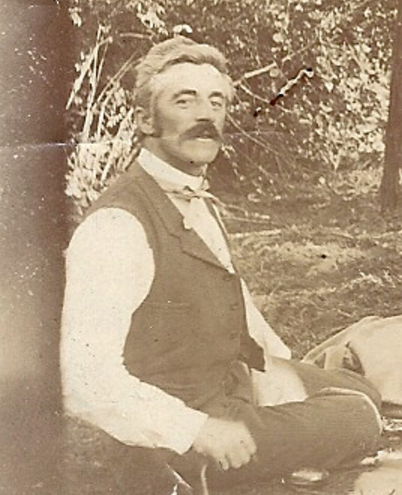
La California
Posted on October 5, 2015 by Royal Rosamond Press

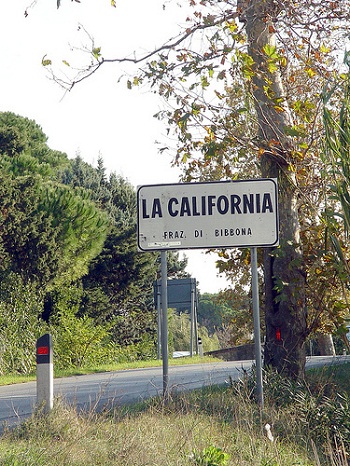
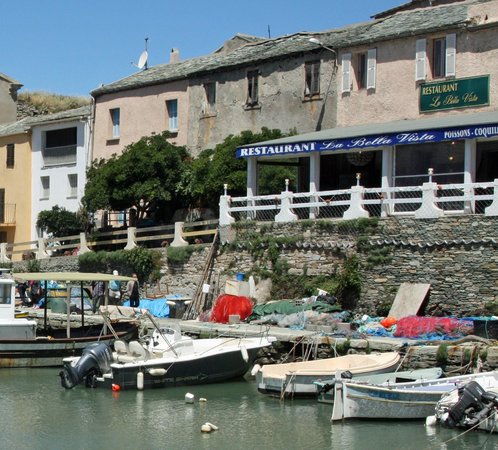
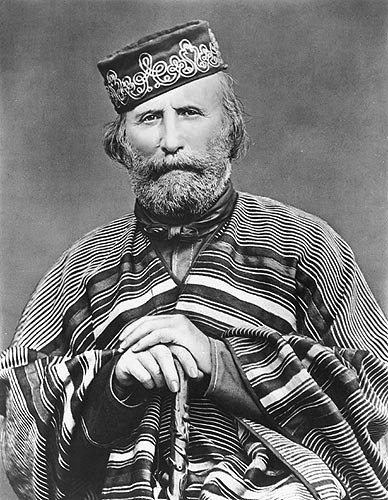
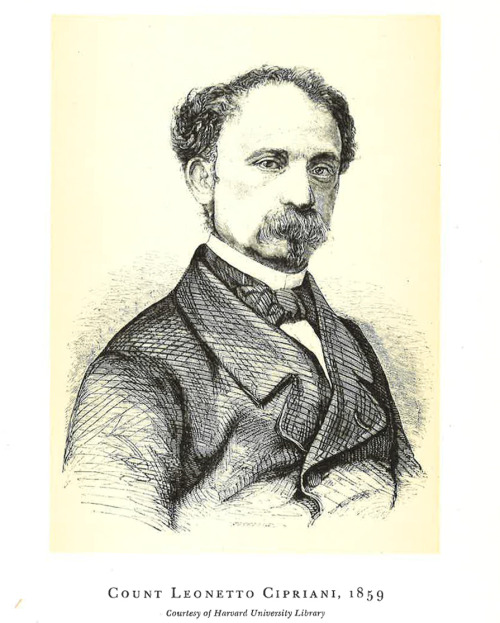
The name Belmont comes from Beaumont. Count Leonetto Cirprini named a province in Italy after California, the place he dwelt. He was the first Italian ambassador and fought the Habsburgs as a Forty-Eighter, who I suspect were going to colonize California. Was Belmont going to be the capital of the Italian Unification, and, this is why Carl Janke brought six portable houses around the Cape? Little Italy?
I am going t establish correspondence, and unite the two Californias.
Jon Presco
“He also describes how he assembled his elegant prefabricated home in Belmont, the first of consequence on the San Francisco peninsula, later to become the Ralston mansion.”
After Victor Emmanuel became King of Sardinia he appointed Cipriani to be his first consul in San Francisco.”
French observers began expressing interest in the idea of a Mexican monarchy as early as 1830. Lorenzo de Zavala claimed that in that year, he was approached by a foreign agent hoping to recruit him in a plan to place an Orléans monarch upon a Mexican throne.[11] In 1840 José María Gutiérrez Estrada wrote a monarchist essay endorsing the idea of a legitimate European monarch being invited to govern Mexico. The pamphlet was addressed to the conservative president Bustamante, who rejected the idea.[12] French diplomats tended to sympathize with the Conservatives in Mexico, Victor de Broglie opining that monarchy was a form of government more suited to Mexico at the time and François Guizot giving a positive review of Estrada’s pamphlet. [13]
Napoleon III saw the opportunity to make France the great modernizing influence in the Western Hemisphere, as well as enabling the country to capture the South American markets. To give him further encouragement, his half-brother, the duc de Morny, was the largest holder of Mexican bonds on which President Juárez had suspended payment.
French troops had been able to take considerable Mexican territory from republican forces while the U.S. was embroiled in its civil war, but in April 1865, Union forces defeated the secessionist Confederate States of America after four years of bloody combat. The U.S. government was reluctant to enter a direct conflict with France to enforce the Monroe Doctrine prohibiting European powers in the Americas, but official U.S. government sympathy remained with Mexican president Benito Juárez. The U.S. government had refused to recognize the Empire and also ignored Maximilian’s correspondence.[27] In December 1865, a $30 million private American loan was approved for Juárez, indicating a confidence that he would return to power, and American volunteers joined the Mexican republican troops.[28] An unofficial American raid occurred near Brownsville, and Juárez’s minister to the United States, Matías Romero, proposed that General Grant or General Sherman intervene in Mexico to help the republican cause.[29] The United States refrained from direct military intervention, but it put diplomatic pressure on France to leave Mexico. [30]
The international situation shifted making a French invasion and establishment of a monarchy in Mexico a real possibility. Conservative Mexican politicians Estrada and Hidalgo managed to get the attention of French emperor Napoleon III, who came to support the idea of reviving the Mexican monarchy and re-establishing a French imperial presence in the Americas. Prior to 1861 any interference in the affairs of Mexico by European powers would have been viewed in the U.S. as a challenge to the Monroe Doctrine. In 1861 however, the U.S. was embroiled in its own conflict, the American Civil War, which made the U.S. government powerless to intervene directly, but it never condoned the French invasion or the regime it established.
In January 1866, seeing the war as unwinnable, Napoleon III declared to the French Chambers that he intended to withdraw the French military from Mexico. At this point, the U.S. government was no longer preoccupied militarily with winning the Civil War and could enforce the Monroe Doctrine against foreign intervention in the hemisphere. Maximilian’s request to France for more aid or at least a delay in troop withdrawals was defused nominally because a possible war against Prussia was coming, so despite the sunk costs of the French occupation, abandoning the enterprise was France’s strategic decision. Empress Carlota arrived in Europe in an attempt to plead for the Empire’s cause, but she was unable to gain France’s support.
A member of the Wimpffen family, de Wimpffen was born in Laon, the illegitimate son of Baron Félix Victor Charles Emmanuel de Wimpffen by Cornélie Bréda. His father was a general in the French Army who had been created a Baron of the Empire in 1810. In 1836 he was recognized by his father.
Entering the army from the military school of Saint-Cyr, he saw considerable active service in Algeria, and in 1840 became captain; in 1847 chef de bataillon. He first earned marked distinction in the Crimean War as colonel of a Turco-Persian regiment, and his conduct at the storm of the Mamelon won him the grade of general of brigade.[1]
In the campaign of 1859 he was with General MacMahon at the battle of Magenta at the head of a brigade of Guard Infantry, and again won promotion on the battlefield. Between this campaign and the Franco-Prussian War, he was mainly employed in Algeria, and was not at first given a command in the ill-fated Army of the Rhine. But when the earlier battles revealed incapacity in the commander of the 5th corps, De Wimpffen was ordered to take it over, and was given a dormant commission appointing him to command the Army of Châlons in case of Marshal MacMahon’s disablement. He only arrived at the front in time to rally the fugitives of the 5th Corps, beaten at Beaumont, and to march them to Sedan.[1]
In the disastrous Battle of Sedan on the first of September, MacMahon was soon wounded, and the senior officer, General Ducrot, assumed the command. Ducrot was beginning to withdraw the troops when Wimpffen produced his commission and countermanded the orders. In consequence it fell to him to negotiate the surrender of the whole French army.[1]
dans : Famille von Wimpffen, Félix Victor Charles Emmanuel de Wimpffen, Naissance en 1778,
et 8 autres
Victor Paladin Stuttmeister
Posted on June 5, 2023 by Royal Rosamond Press

The Victorious Paladin of San Francisco
by
John Presco
Copyright 2023
A week after Victor Paladin Stuttmeister turned twenty-one, his great uncle, John Rosamond Prescowitz died. The executor’s of John’s estate searched high and low for an heir, and alas found Victor. In the reading of the Will, Victor was instructed to talk to the head of Notre Dam Namur, that was just purchased by Stanford. Father Connors was very glad to see Victor, who was led down in the basement into a secret room that was built below the original portable house that Carl Janke brought around the Cape. Count Cipriani had bought one of the six houses after Victor Emanuel made him the Palatine of California. There were a variety of weapons on the walls of this room, along with photographs.
“This is your great grandfather, Victor Ralf Stuttmeister. He was a Paladin. He came to America from Berlin when he was a boy. Leonetti Cipriani took a liking to Victor, and took him on a tour of Italy when he was sixteen. It is alleged the Count initiated Victor in the order of the Paladin Knights, who Charlemagne ordained when he conquered Italy. They descend from Queen Rosamunda and the Welf lineage she and her husband sired . The Paladins made war on the Lombards for many generations. They were hired assassins’ for the Papacy that was loyal to Victor Manuel, the first King of Italy. Victor is a cousin of Victor Emanuel ‘Felix’ Stuttmeister who is buried in the family tomb in Berlin. He was, and you are, the Heir to the Kingdom of Italy.
Victor pulled out two dueling pistols In the trunk.
“Who are these men with my grandfather?”
“The man in the middle is a Sufi Magician steeped in Chinese martial arts. The dangerous looking man was the head of Sardinian Mafia in San Francisco. He was known as the Assassin of Corsica.. His grandson hunted down Nazi generals in Italy, and dispatched them. I am instructed not to tell you his name lest you become too curious. Somethings are best left unknown. What you need to know, is, there are two claimants to your thrown.”
Father Connors handed Victor a scroll with a seal.
“What is this?
This is the perpetual deed to the Presidential suite at the Palace Hotel given to your great uncle by William Ralston, the man who built San Francisco?
“And this?”
“This is the original deed to the Anacondan Mine, that William Sharon came to own after Ralstons apparent sudicded.I have my dobts1”
Tjree days after settling into the Raston Sutie, victoria got a call..
“Hello. My name is Victoria Rosemond Bond. I believe we are third cousins. I just took a DNA test and found you. Do you mind if I and my wife stop by for a visit?
“Sure. I just moved into my fancy digs, and would love to have my kin over!”
Hanging up, Victor contemplated the term “my wife” while he watched Niki Haley tear into LGBTQ folks, like other Republican candidates were.
Victor sighed, and picked up the card that was in the trunk in the hidden Ralston room. He was told he could get free clothing and suits from his kin Johnny Prescowitz, who owned Bullock & Sons. Best dress up for my cousin, even though she is a Lesbian. Is she bringing her wife?
The front desk wanted to warn their new tenant what was coming up the elevator, but felt very threatened. When Victor opened the door, a big Amazon woman dressed in Indian garb gently pushed him against the wall, and expertly frisked him, as if he was being fitted for a suit.
https://en.wikipedia.org/wiki/Paladin
In the Roman imperial period, a palatinus was one of the closest retainers of the emperor, who lived in the imperial residence as part of the emperor’s household. The title survived into the medieval period, as comes palatinus. However, the modern spelling paladin is now reserved for the fictional characters of the chanson de geste, while the conventional English translation of comes palatinus is count palatine. After the fall of Rome, a new feudal type of title, also known simply as palatinus, started developing. The Frankish kings of the Merovingian dynasty (reigned 480–750) employed a high official, the comes palatinus, who at first assisted the king in his judicial duties and at a later date discharged many of these himself. Other counts palatine were employed on military and administrative work.[3]
Franz Emil Lorenz Heeremann Graf von Wimpffen (2 April 1797 – 26 November 1870) was an Austrian General and Admiral who served as Administrative Head of the Austro-Hungarian Navy from 1851 to 1854.
| GeneralfeldmarschallFranz Graf von Wimpffen | |
|---|---|
| Wimpffen photographed by Ludwig Angerer (1860) | |
| Statthalter of the Austrian Littoral | |
| In office 1850–1854 | |
| Appointed by | Franz Joseph I |
| Preceded by | Johann von Grimschitz |
| Succeeded by | Eduard von Bach |
| Rector of Milan | |
| In office 3 August 1848 – 6 January 1849 | |
| Appointed by | Franz Joseph I |
| Preceded by | Gabrio Casati |
| Succeeded by | Antonio Pestalozza |
| Personal details | |
| Born | 2 April 1797 Prague, Bohemia, Austria |
| Died | 26 November 1870 (aged 73) Gorizia, Istria, Austria-Hungary |
| Spouse | Marianne von Eskeles(m. 1825; died 1862) |
| Children | Heinrich Franz Viktor Agidius Maria |
| Profession | Military officer |
| Military service | |
| Allegiance | |
| Branch/service | |
| Years of service | 1813–1870 |
| Rank | Second lieutenant Major general Field marshal Admiral (navy) |
| Unit | Trieste Brigade 1st Austrian Army |
| Battles/wars | Coalition Wars Italian War of 1848 Italian War 1859 |
Contents
Military career
Franz von Wimpffen was born in Prague on 2 April 1797, the son of Karl Franz Eduard von Wimpffen (1776–1842), who served as Chief of the Austro-Hungarian General Staff (from 1824 to 1830), and his wife, Princess Victoria von Anhalt-Bernburg-Schaumburg-Hoym (1772-1817), widow of Landgrave Karl of Hesse-Philippsthal (1757-1793). He was the owner of Kainberg, Reitenau and Eichberg castles and estates in Austria and, as a Roman Catholic, was a Knight of the Sovereign Military Order of Malta. He was commissioned Unterleutnant in October 1813 and served as an artillery officer during the last three years of the Napoleonic Wars, in the German campaign of 1813, the French campaign of 1814, and the Neapolitan War in 1815.
Promoted Generalmajor in 1838, he was given command of a brigade in Trieste. Von Wimpffen was made commander of a division of II Army Corps in Italy in 1846 with the rank of Feldmarschall-leutnant (Lieutenant-Field-Marshal in the Imperial and Royal Austrian Army). He distinguished himself in the 1848 campaign at Vicenza and Custoza. Later, in the Papal States he compelled by bombardment the surrender of Bologna and Ancona. In October 1849 von Wimpffen was named Civil and Military Governor of Trieste and Governor of the Küstenland (Coastal Lands), the region that included the Istrian Peninsula, with the rank of Feldzeugmeister (General of the Artillery in the Austrian Army).
Upon the resignation of Hans Birch Dahlerup in August 1851, von Wimpffen was named his successor as Oberkommandant der Marine (‘High Commander of the Navy’ or Provisional Commander-in-Chief of the Imperial and Royal Navy). During his tenure, the development of the naval base of Pola was accelerated and the naval school at Fiume now Rijeka (Croatia) was converted into the Austrian Naval Academy.
In September 1854, von Wimpffen was dismissed as Oberkommandant der Marine by Emperor Franz Josef against the advice of his military advisers. Von Wimpffen instead took command of I Army Corps. He was succeeded as Head of the Navy by Archduke Ferdinand Maximilian of Austria, the younger brother of Franz Josef.
However well he had performed as Administrative Head of the Navy, von Wimpffen was known in military circles as “the General who had never won a battle”. In the Second Italian War of Independence in 1859, after the defeat at Magenta on 4 June, he seconded the decision of Gyulai, the Austrian commander, to retreat across the Mincio to Mantua, leaving Milan and all of Lombardy to the Sardinians and French. Gyulai was dismissed on 16 June by Franz Josef, who assumed command of the field army with von Wimpffen in command of the Cavalry.
At Solferino (24 June 1859), von Wimpffen and his men fought valiantly, but the Austrians were defeated. The carnage of the battle was so severe that it was soon followed by an armistice and then peace negotiations.
In 1861 von Wimpffen was retired with the rank of Generalfeldzeugmeister (Field Marshal of the ordnance /Field Marshal of artillery in the Austrian Army) and became an Imperial and Royal Advisor to the Emperor of Austria.
He died on 26 November 1870 at Görz (now Gorizia), and was buried at the crypt of the Eichberg castle chapel, in Austria, together with his wife.
Marriage and children
On 5 October 1825, he married Baroness Maria Anna Marianne Cecilia Bernhardine von Eskeles (1802-1862), who converted from Judaism to Catholicism, in Hietzing, Austria. She was born at the Palais Eskeles, Vienna, Austria, on 2 March 1802, daughter of Bernhard von Eskeles and wife Caecilie (Zipperche) Itzig, from whom she inherited a fortune in stocks and bonds, and died in Munich, Bavaria, on 10 August 1862.
They had :
- Heinrich Emil Graf von Wimpffen (1827-1896), succeeded him as head of the comital house.
- Franz Alphons von Wimpffen (1828-1866), Colonel, killed at the Battle of Náchod.
- Viktor Agidius Christian Gustav Maximillian Graf von Wimpffen (Hietzing, Vienna, Austria, 24 July 1834 – Battaglia Terme, Italy, 22 May 1887), was some time Corvette Captain of the Austro-Hungarian Navy, and Inspector-General of Telegraphs in Austria and married in Vevey, Switzerland, on 11 January 1860 Anasztázia (Anastasia) Barónin Sina de Hódos et Kizdia (Vienna, 8 October 1838 – Vienna, 24 February 1889), of Hungarian, Romanian (Ghica family) and Georgian (Dadiani) descent, by whom he had issue.[citation needed]
- Maria von Wimpffen (1842-1918), married Friedrich Balduin von Gagern, had issue.[1]
See also
- Austro-Hungarian Navy
- http://www.wimpffen.hu/
- https://web.archive.org/web/20110719132951/http://www.wimpffen.dk/
- https://web.archive.org/web/20120304055034/http://www.dresselgenealogy.us/a6.htm
Victor Von Janke Stuttmeister
Posted on September 20, 2023 by Royal Rosamond Press
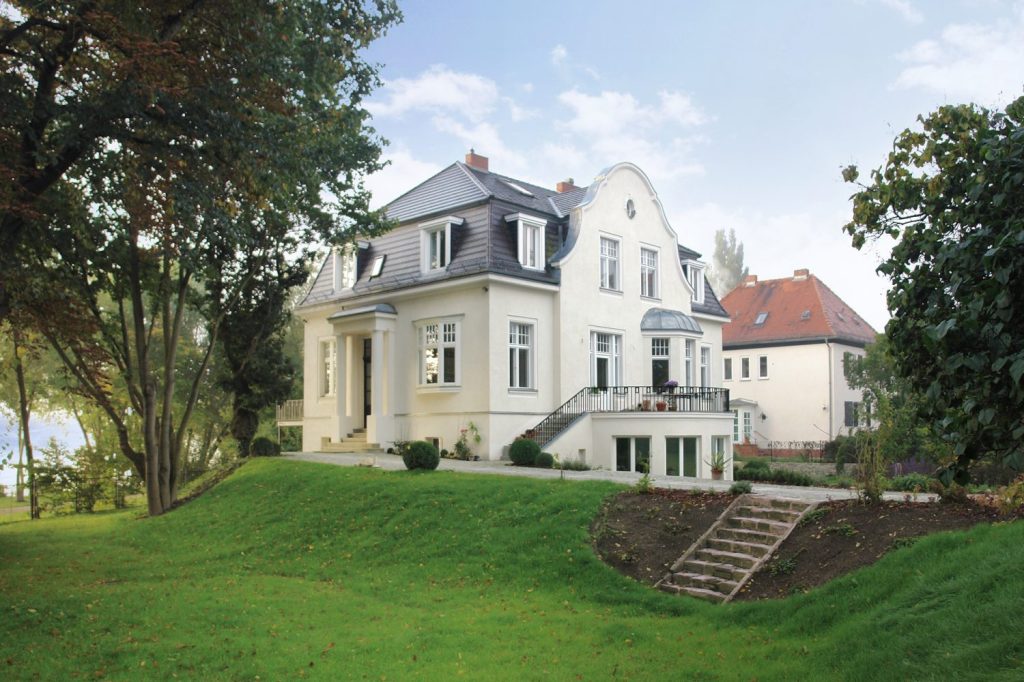
The Day before yesterday I found the Stuttmeister Villa – and Cote of Arms! Last night I tried to watch the Belmont Planning Commission on the Web, but the meeting was canceled.
Félix Victor Charles Emmanuel de Wimpffen
Pour les articles homonymes, voir Wimpffen.
Pour les autres membres de la famille, voir Famille von Wimpffen.
| Félix de WimpffenFélix Victor Charles Emmanuel, baron de Wimpffen | |
| « De Wimpfen devenu général » : portrait probable[1] de Félix Victor Emmanuel Charles, baron de Wimpffen (1778-1813)[1],. Miniature ronde sur ivoire[n 1]. | |
| Naissance | 1er novembre 1778 Bornheim Ville libre de Francfort |
|---|---|
| Décès | 21 juillet 1813 (à 34 ans) Paris |
| Origine | Alsacienne |
| Allégeance | Royaume de France République française Empire français |
| Arme | Infanterie |
| Grade | Colonel |
| Années de service | 1791 – 1813 |
| Conflits | Guerres révolutionnaires Guerres napoléoniennes |
| Commandement | 5e bat. des volontaires du Haut-Rhin 2e bat. de déserteurs étrangers 2e régiment d’infanterie de ligne |
| Faits d’armes | Polotsk (1re) |
| Distinctions | Légion d’honneur |
| Famille | Famille von Wimpffen |
| modifier | |
Félix Victor Charles Emmanuel, baron de Wimpffen (château de Bornburg (de) à Bornheim (Francfort-sur-le-Main), 1er novembre 1778[2] – Paris, 21 juillet 1813[2]), est un militaire français des xviiie et xixe siècles.
Sommaire
Biographie
Appartenant à une famille d’ancienne chevalerie d’Alsace[3], Félix de Wimpffen était le quatrième fils du lieutenant-général François Louis Hérold, baron de Wimpffen-Bornburg, chambellan et ministre du roi de Wurtemberg[4].
Suivant l’exemple de son père et ses aînés, le jeune Wimpffen choisit la carrière militaire. Le 3 octobre 1791, il est élu adjudant-major au 5e bataillon des volontaires du Haut-Rhin[5]. Le 1er janvier 1792, son bataillon est en garnison à Ribeauvillé[5]. Il rejoint ensuite l’armée du Rhin[5].
Le 15 juin 1792, Wimpffen est élu lieutenant-colonel en second du bataillon[5], il n’a alors que quatorze ans[6]. Le 31 août, il est lieutenant-colonel en chef du bataillon[5]. Les représentants en mission, le jugeant comme étant trop jeune pour assurer ce commandement, le suspendent[5].
En 1800, il sert comme adjudant sous les ordres de son père (dont il est l’aide de camp[6],[7]) et passe dans la 95e demi-brigade d’infanterie de ligne[5]. Commandant à Ludwigsburg de janvier à mai 1801, il est ensuite chef de bataillon du 2e étranger à l’île d’Elbe[5] (15 juin 1803[6]).
Passé le 3 septembre 1808 au 13e de ligne[6], il est, en 1809, major au 51e de ligne, puis colonel en second du 2e régiment d’infanterie de ligne[5]. Il remplace le colonel Delga à la tête du corps lorsque ce dernier est tué à Wagram.
Fait baron de l’Empire en 1810[4], le vice-connétable Berthier lui fait l’honneur, le 21 avril 1811, de le présenter à Napoléon[8].
Wimpffen est blessé en Russie, devant Polotsk, le 18 août 1812[7]. Devant de se retirer du service en avril 1813 pour cause de maladie[5], il meurt à Paris le 21 juillet 1813[2].
Ascendance et postérité
Fils puîné de François-Louis-Hérold, baron de Wimpffen (1732-1800) et de Cunégonde-Madeleine de Goy (Francfort, 31 juillet 1743 – ibid. 24 janvier 1820), le baron de l’Empire avait dix frères et sœurs[9],[4], dont :
- Georges, baron de Wimpffen (12 octobre 1760 – Lunéville[4], 27 juin 1807), lieutenant-général russe, marié à Rose Pallas, dont postérité ;
- Charles-François-Eugène, baron de Wimpffen (21 février 1762 – 19 décembre 1835), inspecteur des eaux et forêts, marié, dont postérité ;
- François-Charles-Edouard (de) (Stuttgart, 2 janvier 1776 – Graz, 7 décembre 1842), comte de Wimpffen (par diplôme de l’empereur François II en date du 8 avril 1797[4]), generalmajor wurtembergeois, marié, dont postérité ;
- Dagobert Sigismond Laurent de Wimpffen (1782-1852), marié, sans hoirs ;
- Friedrich Wilhelm (1784-1845), Freiherr von Wimpffen (1834), major-général wurtembergeois[3], marié, dont postérité.
Ascendance sur 5 générations[2]
Félix Victor Charles Emmanuel de Wimpffen épouse Maria Engelthal von Ehrenhorst[2].
- De sa relation avec Cornélie Breda (née vers 1792 à Leuwarde (Pays-Bas))[10], il avait eu :
- Emmanuel-Félix, 2e baron de Wimpffen (Laon, 1811 – Paris, 1884), général de division (5 juin 1859), grand officier de la Légion d’honneur, marié le 13 août 1839 avec Adélaïde Quesnel, sans postérité[4].
Distinctions
Titres
- Baron de Wimpffen et de l’Empire décret du 15 août 1810[11], lettres patentes du 23 décembre 1810[4],[12] ;
- Donataire (r. 2 000) sur Fulde et le Trasimène, par décret impérial du 15 août 1810[4].
Décorations
Héraldique
| Armoiries | Blasonnement |
|---|---|
| Armes du baron de Wimpffen et de l’EmpireSelon ses lettres patentesÉcartelé ; au premier d’azur au bélier grimpant, tenant une croix d’argent, soutenu du même ; au deuxième des barons tirés de l’armée ; au troisième de gueules au faisceau, casque, bouclier et épée d’or, en trophée ; au quatrième de sinople au coq d’argent barbé, crêté et armé de gueules becquetant sur une terrasse d’or[13],[14].Livrées : les couleurs de l’écu, le verd en bordure seulement[13]. | |
| Armes du baron de Wimpffen et de l’EmpireSelon le vicomte RévérendÉcartelé : aux 1er et 4e, d’azur au bélier grimpant tenant une croix, le tout d’argent, soutenu du même ; au 2e, des barons militaires ; au 3e, de gueules au faisceau d’un casque, d’un bouclier et d’une épée, le tout d’or[4],[11].Livrées : les couleurs de l’écu, le verd en bordure seulement[11]. | |
| Le baron de l’Empire appartenait à une ancienne famille d’Alsace, dont les armes sont, selon le vicomte Révérend :De gueules à un bélier couronné d’argent, tenant une croix au pied fiché d’or et posé sur un monticule de trois coupeaux de sinople.[3] |
Notes et références
- ↑ Miniature ronde sur ivoire. Médaillon à bélière double face en or, orné à l’arrière de son monogramme en lettres d’or découpées, posé sur un fond de tressage de cheveux. Sur le verre sont collés une étiquette de la collection Bernard Franck, le no 534 et l’inscription : « De Wimpfen devenu général ». Diamètre 72 mm. Époque Premier-Empire. Portrait d’un officier d’état-major en tenue d’aide de camp de général de brigade, habit bleu, collet bleu ciel, boutons dorés. Il porte le brassard bleu ciel bordé d’or des aides de camp. Il peut s’agir de WIMPFFEN Félix, Victor, Emmanuel, Charles, Baron de (1778/1813), aide de camp de son père le général François de WIMPFFEN, en 1800, colonel au 2e régiment d’infanterie de ligne, en 1809 à l’âge de 30 ans; blessé en Russie devant Polotsk, le 18 août 1812.SourcesGazette de l’Hôtel Drouot 2015, De Maigret 2015.
↑ Revenir plus haut en :1,0 et 1,1 Gazette de l’Hôtel Drouot 2015.↑ Revenir plus haut en :2,0 2,1 2,2 2,3 et 2,4 Roglo 2016.↑ Revenir plus haut en :3,0 3,1 et 3,2 Révérend 1897, p. 403.↑ Revenir plus haut en :4,0 4,1 4,2 4,3 4,4 4,5 4,6 4,7 4,8 et 4,9 Révérend 1897, p. 402.↑ Revenir plus haut en :5,0 5,1 5,2 5,3 5,4 5,5 5,6 5,7 5,8 et 5,9 SEHRI 2015, p. Haut-Rhin.↑ Revenir plus haut en :6,0 6,1 6,2 et 6,3 Dempsey 2002, p. 53.↑ Revenir plus haut en :7,0 et 7,1 De Maigret 2015.↑ Peltier 1811, p. 471.↑ Lehr 1870, p. 221.↑ Base collaborative Pierfit Généanet.↑ Revenir plus haut en :11,0 11,1 et 11,2 Pouliquen 2015.↑ Maltagenealogy.com 2016.↑ Revenir plus haut en :13,0 et 13,1 PLEADE 2011.↑ Bernard-Michel, p. Empire.
Annexes
Articles connexes

Il existe une catégorie dédiée à ce sujet : Félix Victor Charles Emmanuel de Wimpffen.
- Volontaires nationaux pendant la Révolution ;
- Liste des chevaliers de la Légion d’honneur ;
- 95e demi-brigade de deuxième formation ;
- Petites unités étrangères de l’armée napoléonienne ;
- 2e régiment d’infanterie ;
- Liste des membres de la noblesse d’Empire ;
- Liste des barons de l’Empire ;
- Armorial des barons militaires de l’Empire (F-Z) ;
- Première bataille de Polotsk ;
Liens externes
- « Registres de lettres patentes de collation de titres et d’armoiries et armorial » (Archive • Wikiwix • Que faire ?), 1808-1815, Centre historique des Archives nationales (France) sur chan.archivesnationales.culture.gouv.fr ;
- Thierry Pouliquen, « Noblesse d’Empire », W1, sur Les Hommes de Napoléon Ier, 2015 (consulté le août 8, 2016 à 16:05 (UTC)) ;
- Laurent Brayard, « Bataillons de volontaires et armées révolutionnaires », Haut-Rhin, sur sehri-volontaires.com, Société d’Etudes Historiques Révolutionnaires et Impériale, mercredi 7 janvier 2015 (consulté le août 9, 2016 à 15:00 (UTC)) ;
- (en) « Maltagenealogy.com », List of Titles granted during the French Empires, sur http://www.saidvassallo.com (consulté le juillet 14, 2016 à 08:00 (UTC)) ;
- « Emmanuel Félix de WIMPFFEN » , sur le site de Généanet, base de donnée généalogique [fiche] ;
- « Félix Victor Charles Emmanuel de Wimpffen » , sur le site de Généalogie – Roglo, base de donnée généalogique [fiche] ;
- [PDF] « Catalague de la vente du vendredi 3 avril 2015 à l’Hotel Drouot », lot no 337, sur catalogue.gazette-drouot.com, La Gazette de l’Hôtel Drouot (consulté le août 8, 2016 à 17:55 (UTC)) ;
- « Miniature ronde sur ivoire », Portrait d’un officier d’état-major en tenue d’aide de camp de général de brigade, sur http://www.thierrydemaigret.com, Thierry de Maigret, commissaire priseur (consulté le août 9, 2016 à 08:09 (UTC)) ;
- Bruno BERNARD-MICHEL, « Armorial Noblesse Empire », W2, sur http://www.heraldique-blasons-armoiries.com/ (consulté le août 10, 2016 à 08:33 (UTC)) ;
Leave a comment